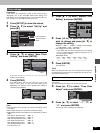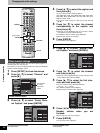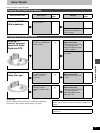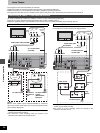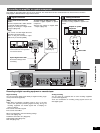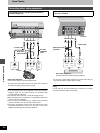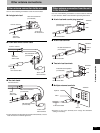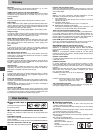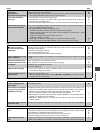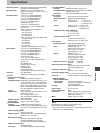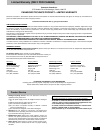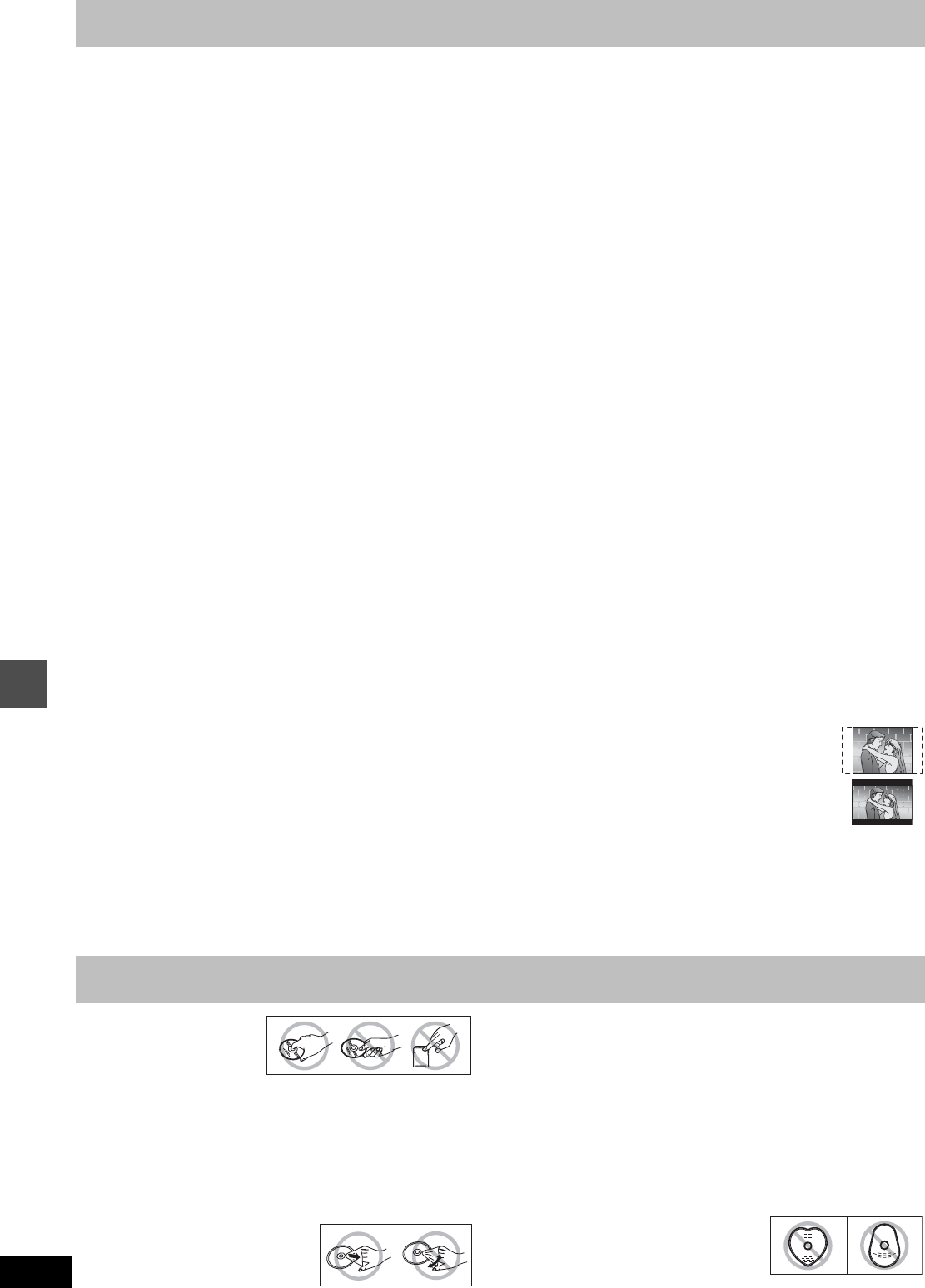
62
RQT6986
Reference
Glossary
Bitstream
This is the digital form of multi-channel audio data (e.g., 5.1 chan-
nel) before it is decoded into its various channels.
CPRM (Content Protection for Recordable Media)
CPRM is the copyright protection technology that is used to protect
broadcasts that are allowed to be recorded only once (e.g. some
CATV broadcasts).
Decoder
A decoder restores the coded audio signals on DVDs to normal.
Dolby Digital
This is a method of coding digital signals developed by Dolby Labo-
ratories. Apart from stereo (2-channel) audio, these signals can also
be multi-channel audio. A large amount of audio information can be
recorded on one disc using this method.
This unit is set to record using Dolby Digital in all recording modes.
Dolby Pro Logic
A surround system where a 4-channel audio track is recorded as 2
channels and then is restored to 4 channels for play. The surround
channel is monaural and can reproduce up to 7 kHz.
DPOF (Digital Print Order Format)
DPOF is the standard printing format for still picture data. It is used
by photo developing stores to print out the still picture data taken
from a digital camera and other equipment or when printing from
your home printer.
Drive
In the instance of this unit, this refers to the hard disk (HDD) and
DVD. These perform the reading and writing of data. Select them by
pressing the drive select buttons ([HDD] or [DVD]).
DTS (Digital Theater Systems)
This surround system is used in many movie theaters around the
world. There is good separation between the channels, so realistic
sound effects are possible.
FAT (File Allocation Table)
The FAT12 (12-bit file allocation table) and FAT16 (16-bit file alloca-
tion table) systems this unit is compatible with are file systems used
widely in computers around the world.
Film and video
DVD-Videos are recorded using either film or video. Usually, film is
recorded at 24 frames per second, the rate movies are filmed at,
while video is recorded at 30 frames per second.
Finalize
A process that makes play of recorded audio and video on a CD-R,
CD-RW and DVD-R possible on play compatible equipment. You
can finalize a DVD-R on this unit.
Frame still and field still
Frames are the still pictures that make moving pictures. About thirty
are shown each second. A frame still may appear blurred but overall
quality is high.
Two fields appear alternately to make up one frame. A field still is
not blurred but picture quality is lower.
Hard disk drive (HDD)
This is a mass data storage device used in computers etc. A disk
with a surface that has been treated with magnetic fluid is spun and
a magnetic head is brought in close proximity to facilitate the read-
ing and writing of large amounts of data at high speed.
Interlace and progressive output
NTSC, the video signal standard, has 480 interlaced (I) scan lines,
whereas progressive scanning uses twice the number of scan lines.
This is called 480P.
I/P/B
MPEG 2, the video compression standard adopted for use with
DVD-Video, codes frames using these 3 picture types.
I: Intra coded picture
This picture has the best quality and is the best to use when
adjusting the picture.
P: Predictive coded picture
This picture is calculated based on past I- or P-pictures.
B: Bidirectionally-predictive coded picture
This picture is calculated by comparing past and future I- and
P-pictures so it has the lowest volume of information.
JPEG (Joint Photographic Experts Group)
This is a system used for compressing/decoding color still pictures.
If you select JPEG as the storage system on digital cameras etc.,
the data will be compressed to 1/10–1/100 of its original size. The
special quality of this standard is that there is little deterioration in
picture quality in comparison to the degree of compression.
Linear PCM (pulse code modulation)
These are uncompressed digital signals, similar to those found on
CDs. LPCM sound is available when recording in XP mode.
MPEG2/MPEG4 (Moving Picture Experts Group)
A standard for efficiently compressing and expanding color video.
MPEG2 is a compression standard used for DVD and satellite
based digital broadcasting and this unit records programs using
MPEG2.
MPEG4 is a compression standard created for use with mobile
equipment and use over networks, providing highly efficient record-
ings even with low bit rates.
Playback control (PBC)
If a Video CD has playback control, you can select scenes and infor-
mation with menus.
Pan&Scan/Letterbox
In general, DVD-Video discs are produced for viewing on wide-
screen televisions with an aspect ratio of 16:9. This means you can
view most material with the intended aspect ratio on a widescreen
television.
Material with this ratio will not fit onto a standard television with an
aspect ratio of 4:3. Two styles of picture, “Pan&Scan” and “Letter-
box”, deal with this problem.
Pan&Scan:The sides are cut off so the picture fills
the screen.
Letterbox: Black bands appear at the top and bot-
tom of the picture so the picture itself
appears in an aspect ratio of 16:9.
TIFF (Tag Image File Format)
A still picture data standard. A common format for storing high qual-
ity images on digital camera’s and other devices.
∫ How to hold a disc or
card
Do not touch the play surface or
the terminal surface.
∫ If there is dirt or condensation on the disc
Moisture may condense on discs after they are brought inside from
the cold.
DVD-RAM and DVD-R
Clean with an optional DVD-RAM/PD disc cleaner (LF-K200DCA1,
where available).
Do not use cleaners or cloths for CDs to clean DVD-RAM and DVD-R.
DVD-Audio, DVD-Video, Video CD, CD
Wipe with a damp cloth and then wipe dry.
∫ Handling precautions
≥Do not attach labels or stickers to discs. (This may cause disc
warping, rendering it unusable)
≥Do not write on the label side with a ball-point pen or other writing
instrument.
≥Do not use record cleaning sprays, benzine, thinner, static electric-
ity prevention liquids or any other solvent.
≥Do not use scratch-proof protectors or covers.
≥Do not expose the terminals of the card to water, garbage or other
strange things.
≥Do not use the following discs:
–Discs with exposed adhesive from removed stickers or labels
(rented discs etc).
–Discs that are badly warped or
cracked.
–Irregularly shaped discs, such as
heart shapes.
Disc handling




